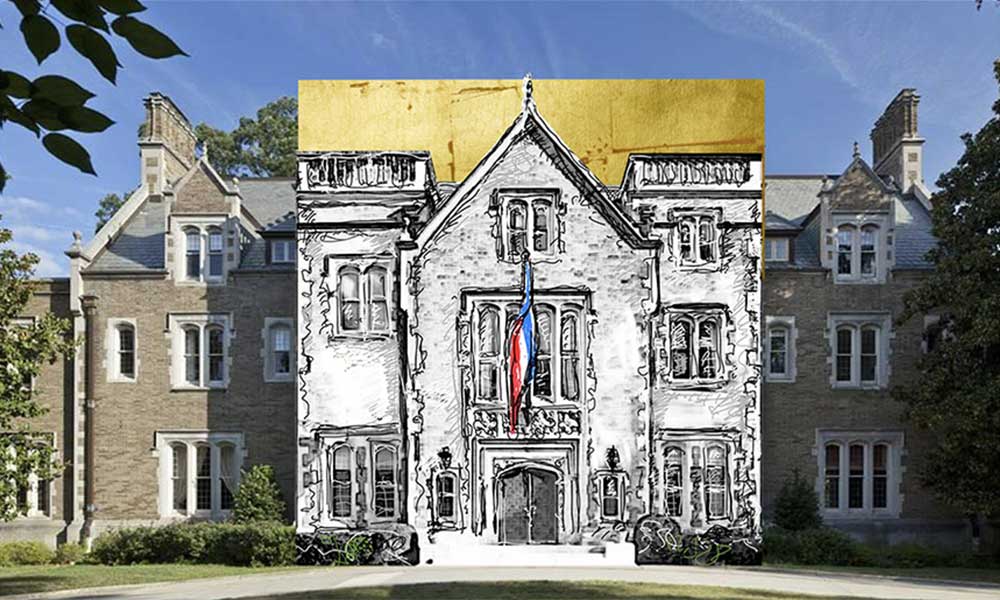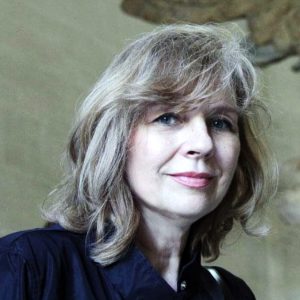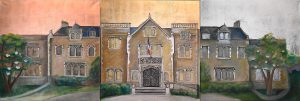Creating Streetscape Art: An Interview with Simonida Perica Uth
"Simonida's Artist's inspiration has for decades brought the love of France and Paris to the Washington Art scene. Her iconic style fuses Eastern and Western traditions in one ever present, timeless sky" Philippe Etienne the Ambassador of France to the United States


Simonida Perica Uth
Born in Serbia, artist Simonida Perica Uth has made Washington, DC, her home for many decades. She comes from a long line of artists and has had an enduring fascination with French culture, art and architecture. “I adore comparing architecture to the construction of the human body,” she has said. “They both give us a glimpse into the secret of what time truly is—the changes to the form, how it morphs and develops—and yet there is an exotic memory of the past, like visiting an ancient temple.” Moment Arts Editor Diane M. Bolz recently interviewed Uth (who is a featured Moment Gallery artist) about her latest project for the French Embassy.
I understand that over the years, you’ve done a number of projects in conjunction with or for the French Embassy (La Maison Francaise) in Washington, DC and that you have a new, very exciting project. Can you tell me a little about it?
The first time I was contacted by the embassy was literally 30 years ago. They said they had a modest budget and wanted to know if I could do a stage design. “We need a pretty stage design,” they said, “something artistic for Bastille Day.”
So I was thinking, “What can I do with a small budget?” And then, I came up with a very modern idea. I borrowed three mannequins, you know the doll mannequins that you dress up with clothes. So, I borrowed three, promising I’m going to return them in good shape. And then I wrapped them up like the artist Christo would do, in plastic, and I spray-painted them blue, white and red. Then I had a guy make three wooden panels, and I sprayed them blue, white and red with a wavy line so they looked like a flag. And then I placed the painted mannequins in front of the “flag.” It looked wonderful.
I did several other Bastille Day designs, and then I got my first commission for a work of art, which was to do a painting of the coat of arms of Paris. That work is now part of the embassy’s permanent collection and hangs there today, just next to a work by Fernand Leger, which I feel is such an honor.
And what about the current project you’re doing for the embassy?
This past February, the head of events at the embassy suggested to me there would be some kind of a competition coming up. They were looking for someone to do a painting of the French ambassador’s residence, which was in the process of being restored. Scaffolding was going to go up all around the building and they wanted to make a drape or screen to hide it. So they needed a painting that could be reproduced, blown up and printed on canvas at life-size to hang over the structure of the scaffolding.
So, I made a proposal, and I waited until May to find out that the ambassador approved my sketch. Once I got that approval, I bought the canvases and other materials I needed. I divided the painting into three square panels (36” x 36”), because the building is very long and not so high and also to make it easier to transport. I always have such trouble with large canvases, because of the transport. It’s very expensive and the works get damaged. I therefore split the image of the French ambassador’s residence into three pieces, so the painting is actually a triptych.
And then I decided to make the three sections of the painting unique, because there is not too much freedom of expression when you just do a building, when it’s just the architecture. I didn’t want to be too literal, too rigid, and just render the building like a photograph, where everything is geometrical, precise, and that’s that. I wanted to do something more creative. Otherwise, why not just do a photograph.

Triptych painting of French ambassador’s residence by Simonida Perica Uth
Next, I decided to use metal leaf and depict the three sections as morning, midday and evening. For the morning, I chose silver leaf to symbolize that crisp, sharp color—fresh, cold morning light. For noon I picked gold, because the sun is at its zenith. It’s throwing a beautiful golden shine on things. And then for the evening, the sunset, I used copper leaf—the pinky, coppery, warm, deeper color signifying that time of day. The lighting or time-of-day effect is very French, following in the tradition of Claude Monet and his paintings of the Rouen Cathedral at different times of the day.
The ambassador’s residence is a very unusual yellow brick with stone trim on the windows and doors. It’s a neo-Tudor style of architecture, but they also call it Beaux Arts. It’s an eclectic style of architecture. It was built in 1910 and designed by the French-born architect Jules Henry de Sibour. There are also on each side, left and right, of the building beautiful old magnolia trees that I included. My style is a mixture of East and West influences. For instance, gold and silver metal leaf was used in Orthodox and Buddhist iconography. Why gold? Gold is a metal that doesn’t oxidize. It’s eternal. So, there is a very transcendental feel to it. I introduced copper as a new material in my work.
When you first started work on this project, I presume you went to visit the building. Did you do any sketches on site, or did you take photographs?
I took a photograph. Because of security and everything, I couldn’t be sitting there for a long time while sketching. I then worked up sketches based on the photograph on my iPad Pro. And then I did a sketch in paint overdrawn with black lines. I love the French painter Gustav Moreau. He was the first one to introduce line and drawing on top of the paint. Painting is dealing with colored surfaces, not with black and white. What I did, I took a step even more obvious. Moreau was a little bit delicate. I’m not delicate about it. I really go black and white on top of the color.

What kind of paint and other materials did you use for this project?
For this particular project, I had to use acrylic and then I added metal leaf. I had just one month to finish all three paintings. If I had used oil, it would have brought me into a different style and would have taken more time. Acrylic gives me the best chance to do what I want to do with line and surface. There are basically five layers of different colors in the painting. If you want, for example (it’s an old Japanese technique), a perfect white, you don’t put down the white paint, you under paint with red. Or with blue, or with whatever.
Just so I understand, the procedure then is that the embassy will take your painting and have it blown up to life-size and then printed on some kind of cloth or canvas?
It’s going to be on a canvas that will be tied up on the scaffolding so it will hang just in the front of the building in order to hide the scaffolding. It will probably be printed in sections or strips of canvas that will then be joined together.
So it’s like a screen.
Exactly. It will cover up the ugly scaffolding and it will create an art happening.
And when do you anticipate it being installed?
I think that will happen in October.
Going back to your roots, do I understand correctly that your father was an artist and graphic designer?
Yes. So, I kind of followed his path. I graduated from the graphic department of the School of Industrial Design, a special arts high school in Belgrade, and I went on to the University of Fine Arts, also in Belgrade, where I got my BFA and then my master’s, which was in monumental Byzantine art. I had to actually build a wall—mix my own mortar, create the wall by myself, and then apply fresco. I did a mosaic as well.
There’s one additional thing I wanted to ask you about. As I understand it, your grandfather was actually in a concentration camp in Croatia during the Nazi occupation and managed to escape.
My great-grandfather, whose last name was Perica, was a judge on the Dalmatian Coast and would travel from place to place. The Perica family, who were Sephardic, left Gerona, Spain, during the Reconquista and moved to Dalmatia. My great-grandfather first married a Czech lady and then a Venetian lady. So my grandfather, his son, grew up on the Dalmatian Coast and lived there when the Nazis came. He and his half brother, as Jews, were both put in a concentration camp. But they somehow managed to run away, and they walked through Austria and Hungary, saving themselves by sleeping in cemeteries at night. Because people were scared of cemeteries and didn’t look there. And the two of them made their way to Belgrade, which was then a safe haven. There, my grandfather worked in the government ministry for a minister of Yugoslavia, and he was painting in his private time. He loved art. And that’s how my father got interested in painting. When I was a child, my family celebrated Passover (my favorite holiday) along with Orthodox Christmas and Easter, in secret since in communist Yugoslavia it was not desirable to be religious. My interest in Judaism was sparked by David Albahari’s translation into Serbian of Gershom Scholem’s On the Kabbalah and Its Symbolism. I’ve always been interested in the hidden meanings of symbols.
So that’s how you came to be born in Belgrade. What a fascinating story. One final question about the French Embassy project: Do you think there’s a chance that President Macron will see your art when he comes for his planned state visit on December 1?
I certainly hope so. I would be thrilled if he does and would love to know his reaction.

One thought on “Creating Streetscape Art: An Interview with Simonida Perica Uth”
Fascinating, another Kafka and dance of Tamara,
Vrubel / something fresh and yet, ancient Bizantium is on table !
Simonida Uth doesn’t need to talk, she needs to “paint” and scream through canvas and color!
Majestic!
Maria Doverspike, professor of comparative literature